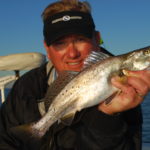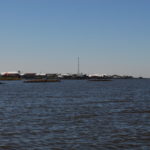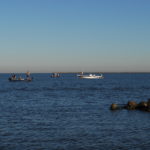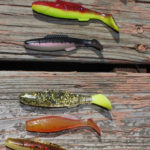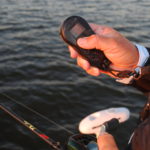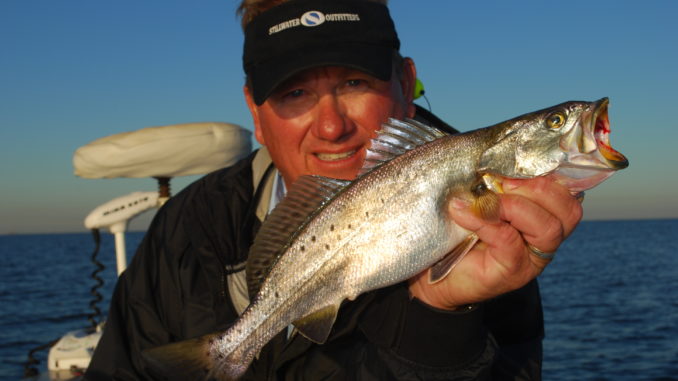
Anglers don’t have a very long season to catch keeper trout close to the landing at Cypremort Point, but when it’s on, there’s no place better.
Meet Capt. Steve Smith.
Steve’s an odd duck.
Actually, he’s not odd. He is a pretty normal-looking 52-year-old guy, sandy haired with closely set, intelligent, bright blue eyes.
But what he does is odd. He is a Cypremort Point charter fishing guide. And he loves to chase speckled trout. There are fewer fishing guides that work out of the area than there are fingers on one hand, and most of those specialize in redfish.
The waters of Vermilion Bay and offshore of Marsh Island are without a doubt one of Louisiana’s most overlooked trophy speckled trout hotspots. Smith modestly but firmly calls the area “underutilized.”
If the average speck fisherman in Louisiana is asked where the greatest trophy speckled trout fishing hole in the state is, odds are strong he would answer “Calcasieu” or perhaps “Pontchartrain.”
But a look at the results of the Coastal Conservation Association’s STAR Tournament over the last nine years tells a different tale. The biggest fish of the year came from Cypremort Point four of those years. Lake Pontchartrain fish took biggest-fish honors three times during that period, and Calcasieu Lake did it twice.
Yet the area has few charter guides and remains relatively unknown outside of the immediate area.
“We only get about 100 days of good fishing a year here,” Smith said. “Everything depends on salinity and water clarity, and Atchafalaya River discharges really affect us.”
Most years, he explains, the Atchafalaya River rises enough to pour muddy, fresh water into Vermilion Bay and over the reefs and rigs offshore of Marsh Island and West Cote Blanche Bay by January. When this happens, it is over.
“Even the best of fishermen won’t catch trout,” he said.
The high river pattern typically stays in place through well into May, although a few breaks can occur offshore as early as April. West winds that hold steady for several days will push the Atchafalaya River discharge plume eastward and replace it with clearer, higher salinity waters.
During these short windows, fishermen with enough boat under them can run offshore to Tiger Shoals, Vermilion Blocks 51, 52 and 233 and the platforms locally known as Dead Pelican and Four Posts. Runs are a minimum of 7 miles from Cypremort Point, and can be as long as 17 miles one way.
Most speck fishermen, however, are still out of commission until the Atchafalaya River at Butte La Rose falls until it hits the 10-foot mark, the magic number that lets some salt water into Vermilion Bay. Smith still considers the bay “iffy, at best” for May.
By the typical June, or at latest July, things are usually looking up for Vermilion Bay speck fishermen. Most of the early action in the bay proper will be in deeper waters such as those around the Dry Reef Compressor Station and its associated well guards in the middle of the bay.
The most consistent action, however, will still take place on the nearshore reefs south of Marsh Island such as Tete Butte, Diamond and Pavey reefs. This action carries over into August, although the speckled trout begin to move inward. As the rigs offshore begin to slow down, fishing picks up on the Shell Keys and Nickel Reef.
By September, all eyes are turned inward toward Vermilion Bay. The rigs offshore are done, but the vagaries of the transition mean that the speckled trout are not locked in yet to their early winter pattern. Bird action can be hot, but competition with other anglers for position near the diving and feeding birds can be hotter.
Then comes October, followed by November and December — prime time in the bay and prime time for one of the bay’s hottest spots, the area known as The Cove.
The Cove will be his target tomorrow, Smith explains while searing a small part of the day’s catch of speckled trout on the professional griddle in the huge kitchen of his Cypremort Point camp.
The pre-dawn air the next morning has a bite. I push my chin down into the collar of the coat that I am glad I thought to bring on board. After exiting the Hammock Canal, Smith jumps his 25-foot Shearwater up on step, and runs it around the tip of Cypremort Point. To the south, the lights of the Dry Reef platform complex glitter brightly like a marine city in the dry, clear air.
He swings wide around the point and heads north, then east to within good paddling distance of the boat launch at Cypremort State Park, locally known as the Quintana Landing. Before the sun’s first rays peek over the live oaks crowning the point, Smith has eased his trolling motor down and begun his drift.
The strategy is simple and one that most experienced cove fishermen use. Pushed by the wind, he will drift through the area, using his trolling motor mainly to keep his boat from drifting too near other boats.
When he hooks up on a fish, he immediately spuds down with his Power-Pole Shallow Water Anchor, holding the boat in position to thoroughly work the spot for other fish. Where there is one speck, there are often more.
The northeast wind blowing today is perfect for the drift, a rectangular area extending from outside the landing on the northeast end southwesterly down to where the waterfront camps and their piers begin. Fishing is concentrated within 300 yards of the segmented rock breakwaters that line the marshy edge of the point. Farther out, the bottom changes from oyster shell on mud to open mud, and fishing success declines.
His first trout is a 13-incher, one that many other fishermen would keep as a “good eater.” Smith tosses it back.
“We’re going to do better,” he confidently predicts.
With the Power-Pole down, he combs the area looking for the little guy’s big brother. After picking up a couple more fish, he picks up his Power-Pole and again lets the wind fuel his drift.
At the bottom end of the drift, he trolls well south of the fishing area, cranks his big motor and swings west, then north and then east to begin the drift again. Each drift produces a few fish, a lot different than yesterday, when the first stop produced a limit of 25 beautiful specks, topped off by another dozen or so that he caught and released just for fun.
Fishing the Cove is far more a matter of finding where the fish are holding and then capitalizing on that concentration than it is going to specific locations that have consistently held fish in the past.
While Smith often offers topwater lures and occasionally suspending plugs, fall and early winter in the Cove finds the guide chunking queen-sized paddle-tail plastic lures on ¼-ounce (3/8-ounce on strong tides) jig heads.
Smith keeps his color selection simple. For darker waters, his favorite is what he calls “LSU,” a hideous purple and gold creature that the manufacturer calls “plumtreuse.” He laughs when he explains that he bought them the first time on sale for 88 cents a pack, probably because no one else would buy them.
Other dark-water favorites are glow with a chartreuse tail, black over white (tuxedo) and motor oil. He favors lighter colors for lighter waters, including bubble gum, sparkle with a chartreuse tail and chicken on a chain.
His theory is that if the water is dark, a dark bait that casts a shadow or silhouette is better. In clear water, the fish will see a dark lure too well and not strike it. Lighter lures more closely resemble translucent live baits such as young pogies or other fish.
The veteran Vermilion Bay angler uses a variety of retrieves: dragging the lure smoothly on the bottom, hopping it slightly off the bottom, fast high twitching or steady swimming it just over the bottom. When a cast results in a fish, he repeats it until he loses confidence in it, then starts experimenting all over again.
The good fishing in the Cove is obviously not a secret. Two boats are there before him. By sunrise, the count is six, by 8 a.m., it is 21. At 9 a.m., when Smith leaves to explore another spot, 27 boats are drifting, anchoring, then drifting again.
Most of the anglers are skillful and the area easily accommodates them — until an aluminum bass boat approaches from the south, plowing as fast as it can go while keeping its full length in the water and throwing a monster wake. The approach is as subtle as a bowling ball approaching the pins. For the performance’s finale, the angler in front shot-puts an aircraft carrier-sized anchor in a perfect overhead arc.
The mild-mannered Smith quietly sighs and picks up his trolling motor. He wants to try another spot — the Hammock, a bed of cypress stumps off a secondary point just southeast of Cypremort Point. The point itself, marked on some maps as Dead Cypress Point, once extended much farther in a southwesterly direction into Vermilion Bay. A dead cypress tree at this spot gave the Cypremort Point its name. Cypremort translates as “dead cypress.”
The fishing strategy here is the same as in the Cove — a wind-driven, trolling motor-controlled drift over the fishing area, followed by others that begin at slightly different spots. Here also, he anchors immediately when he picks up a fish.
Smith fishes his plastic here slowly, almost crawling it through the submerged woody debris like a bass angler retrieving a worm. He picks up a few trout here, but the spot is too exposed to the northeast wind, and he soon returns to the Cove to finish the day.
Smith, who guides on Calcasieu Lake when the Vermilion-Marsh Island area is flooded with Atchafalaya River water, clearly has his heart at Cypremort Point.
“This estuary as a whole holds big fish,” he said. “We do catch nice fish.
“On any given day, with good conditions, you have a chance at a 5-pound trout.”
It’s a shame it’s only a hundred days.
Steve Smith is a featured guide in the forthcoming book Trout Masters Too: How The Pros Do It. The book, a companion book to Trout Masters: How Louisiana’s Best Anglers Catch The Lunkers, will be available in spring 2012.
To contact Smith, call 337-654-3880.
